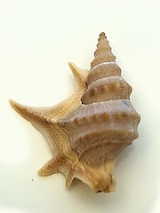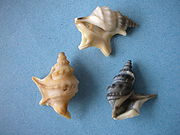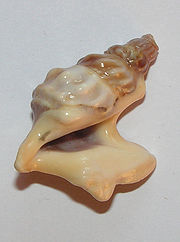
Aporrhais pespelecani
Encyclopedia
Aporrhais pespelecani, common name
the "pelican's foot", is a species
of sea snail
, a marine
gastropod mollusk in the family
Aporrhaidae
.
In the early 20th century the scientific name was sometimes written with a hyphen and spelled "pes-pelicani". http://books.google.com/books?id=UcITAAAAYAAJ&pg=PA73&lpg=PA73&dq=pes-pelicani&source=bl&ots=9KY4ltqtQT&sig=NDfZs0S6wSsBb-1H1jn1WPiEjCM&hl=en&sa=X&oi=book_result&resnum=6&ct=result
.
The specific name is often spelled pespelicani by analogy with the modern spelling of the word "pelican", however this is incorrect. It was not the original spelling as used by Linnaeus, the original authority of the species, which he called Strombus Pes pelecani. The rules of the ICZN
state that the original spelling of a species name is the correct one, even in cases where the word was originally misspelled, or is not in line with current spelling. However in this case, the specific name must now be written as one word, not two, and cannot be hyphenated.
, from Norway to the Mediterranean Sea http://www.animalbase.uni-goettingen.de/zooweb/servlet/AnimalBase/home/species?id=3609 and also in the Black Sea
http://www.grid.unep.ch/bsein/redbook/txt/aporrhai.htm.


Common name
A common name of a taxon or organism is a name in general use within a community; it is often contrasted with the scientific name for the same organism...
the "pelican's foot", is a species
Species
In biology, a species is one of the basic units of biological classification and a taxonomic rank. A species is often defined as a group of organisms capable of interbreeding and producing fertile offspring. While in many cases this definition is adequate, more precise or differing measures are...
of sea snail
Snail
Snail is a common name applied to most of the members of the molluscan class Gastropoda that have coiled shells in the adult stage. When the word is used in its most general sense, it includes sea snails, land snails and freshwater snails. The word snail without any qualifier is however more often...
, a marine
Marine (ocean)
Marine is an umbrella term. As an adjective it is usually applicable to things relating to the sea or ocean, such as marine biology, marine ecology and marine geology...
gastropod mollusk in the family
Family (biology)
In biological classification, family is* a taxonomic rank. Other well-known ranks are life, domain, kingdom, phylum, class, order, genus, and species, with family fitting between order and genus. As for the other well-known ranks, there is the option of an immediately lower rank, indicated by the...
Aporrhaidae
Aporrhaidae
Aporrhaidae, common name the pelican's foot snails, is a taxonomic family of sea snails. The taxonomy of the Gastropoda by Bouchet & Rocroi, 2005 categorizes Aporrhaidae as marine gastropod mollusks in the clade Littorinimorpha....
.
In the early 20th century the scientific name was sometimes written with a hyphen and spelled "pes-pelicani". http://books.google.com/books?id=UcITAAAAYAAJ&pg=PA73&lpg=PA73&dq=pes-pelicani&source=bl&ots=9KY4ltqtQT&sig=NDfZs0S6wSsBb-1H1jn1WPiEjCM&hl=en&sa=X&oi=book_result&resnum=6&ct=result
Etymology and nomenclature
The specific name pespelecani is Latin, and means the same thing as the common name: "pelican's foot". This name is based on the shape of the three-pointed (or four-pointed) expanded outer lip of the adult shell, which resembles the webbed foot of a sea bird such as a pelicanPelican
A pelican, derived from the Greek word πελεκυς pelekys is a large water bird with a large throat pouch, belonging to the bird family Pelecanidae....
.
The specific name is often spelled pespelicani by analogy with the modern spelling of the word "pelican", however this is incorrect. It was not the original spelling as used by Linnaeus, the original authority of the species, which he called Strombus Pes pelecani. The rules of the ICZN
International Code of Zoological Nomenclature
The International Code of Zoological Nomenclature is a widely accepted convention in zoology that rules the formal scientific naming of organisms treated as animals...
state that the original spelling of a species name is the correct one, even in cases where the word was originally misspelled, or is not in line with current spelling. However in this case, the specific name must now be written as one word, not two, and cannot be hyphenated.
Distribution
This snail lives in the Eastern Atlantic OceanAtlantic Ocean
The Atlantic Ocean is the second-largest of the world's oceanic divisions. With a total area of about , it covers approximately 20% of the Earth's surface and about 26% of its water surface area...
, from Norway to the Mediterranean Sea http://www.animalbase.uni-goettingen.de/zooweb/servlet/AnimalBase/home/species?id=3609 and also in the Black Sea
Black Sea
The Black Sea is bounded by Europe, Anatolia and the Caucasus and is ultimately connected to the Atlantic Ocean via the Mediterranean and the Aegean seas and various straits. The Bosphorus strait connects it to the Sea of Marmara, and the strait of the Dardanelles connects that sea to the Aegean...
http://www.grid.unep.ch/bsein/redbook/txt/aporrhai.htm.
Habitat
This species of sea snail lives below the low tide level, in the sublittoral zone, from 10 to 130 m depth, on mud or muddy sand. The empty shells do sometimes wash up on beaches however.

External links
- Image of two live individuals on mud http://www.marlin.ac.uk/php/image_viewer.php?images=apopes2&topic=Species

